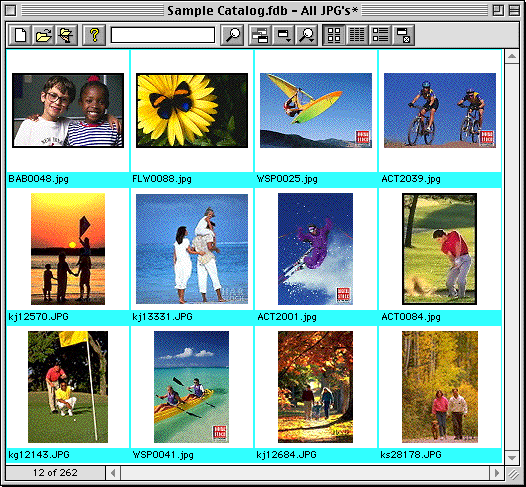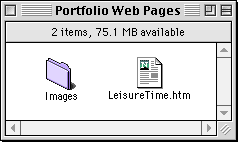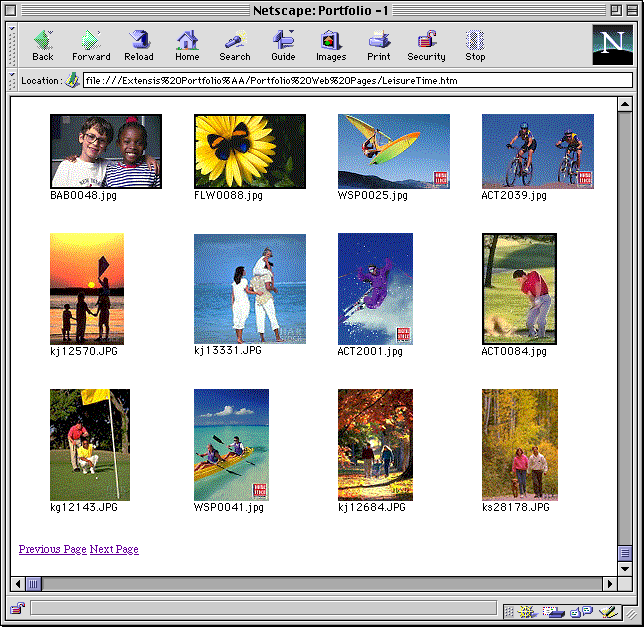The Portfolio Export to HTML function allows you to export catalog items as static Web pages, for posting on a Web Server.
You can specify either that the HTML pages produced will be based on the items and the layout of the currently active Gallery view, or you can specify that Portfolio export the pages using a custom HTML settings file (Template).
Tip: For sample templates and more details about Exporting HTML from the Portfolio client, see Export HTML Templates.
To export catalog items as Web pages just as they appear in the active Gallery:
Select the desired Gallery view and customize it so that it looks just like you want it to look when viewed on the Web. Thumbnails are exported in the order that they displayed in the catalog.
Portfolio creates the Web page layout with the items positioned just as they are in the Gallery, so you may want to reorder the items to create just the right display.
Select the records that you want to export.
You must indicate which items in the Gallery you want to export.

Choose File > Export > HTML [Command+Option+H (Mac OS) or Ctrl+Shift+H (Windows)].
The Export HTML dialog will be displayed.
In the Export HTML dialog, choose “Use Current View Settings,” then click “Export.”

Portfolio will ask you to enter a file name for the first HTML page, and locate where to save the HTML file that are created.
If more than one page of HTML is required (depending on how many records were selected), Portfolio will generate additional pages and place them in the same location as the first file. All the Web page files will start with the file name you entered, followed by a hyphen (“-”) and a number corresponding the page number. For example, if the first file was named “PortWeb.htm”, the second file will be named “PortWeb-1.htm,” etc.
Click “Save” to start the export process.
Portfolio will also create a folder named “Images” at the same location as the Web pages. Portfolio will store JPEG thumbnails of each of the selected items in the Images folder. If any files (either the HTML files or the thumbnail images) already exist in this location, you will be asked whether you want to replace the files or stop the export process.

Open the new Web page(s) in your Web browser to preview the results.

Portfolio's HTML Export process generates relative links. This allows you to upload the folder of exported items (all the HTML pages and the Images folder) to your Service Provider or to a Web site on your corporate intranet and have the items published without hand-coding any HTML and without manually linking the images and pages. Contact your Internet Service Provider or System Administrator for assistance in uploading and publishing your folder of catalog Web pages.
Technical Notes about Exporting HTML
Portfolio does not export borders in the HTML documents. Any border settings in the Gallery view will be ignored.
Portfolio exports thumbnails at the size they were when cataloged, not at the selected display size in the Gallery window. If the thumbnails in the catalog were stored at different sizes, the HTML output will display the thumbnails at different sizes. It is generally recommended that the exported records all use the same size thumbnails. If you do have thumbnails of different sizes, use the Modification Method “Update Unconditionally” and enable Regenerate Thumbnails (Cataloging Options: Rules tab); this forces the thumbnails to be reset to one size. Be aware that the 256 x 256 thumbnails are roughly four times larger than the 112 x 112 thumbnails, so download times over the Internet could be significantly longer if you use this size, depending on the user's bandwidth.
Besides being able to automatically export HTML based on the current Gallery setup, Portfolio can export your catalog items as Web pages using HTML coding that you provide. This gives you great flexibility in creating catalog layouts for the Web.
The HTML information that you enter can be saved as a template. Any HTML Templates that you create are saved within the Portfolio catalog, so you can quickly export any set of records to Web pages using your pre-defined formats at any time.
To export catalog items as Web pages using an HTML Template:
In the active Gallery, select the records that you want to export as Web pages. The records will be exported in the order they are displayed in the gallery, so rearrange the records if desired.
Select File > Export > HTML (or press Command-Option-H [Ctrl+Shift+H]).
The Export HTML dialog will be displayed.
In the Export HTML dialog, click “Add...” to create a new HTML Export Template.
The Edit HTML dialog will be displayed, showing the HTML codes and tags representing the current Gallery view.
Enter a name for the template.
Choose the number of rows and columns of thumbnails that you want to display on each page.

This selection controls how many items fit on a page, and as a result, how many pages are generated for each export based on the number of items you have selected.
Edit the HTML as necessary to produce your desired result. See the following section for details about the three HTML data blocks.
Click ‘OK’ to save the Template and return to the Export HTML dialog.
In the Export HTML dialog, choose the “Use Template” radio button and select your template in the list.

Click “Export” to generate the Web page(s) based on the information you configured in the template.